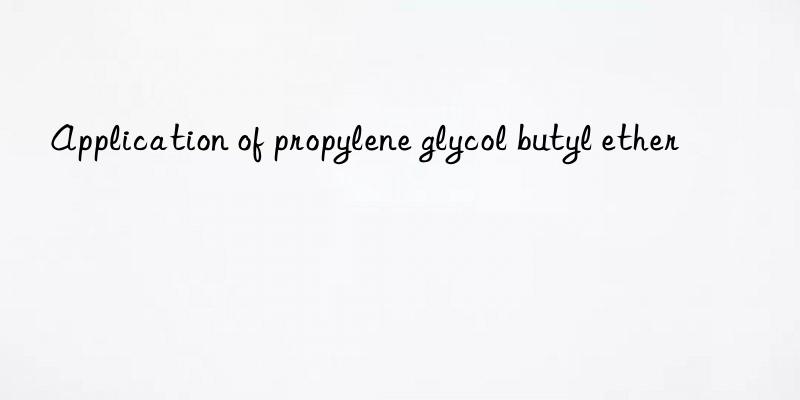
Background and overview[1][2]
The molecular structure of propylene glycol butyl ether contains ether bonds and hydroxyl groups. The former is lipophilic and can be miscible with hydrophobic compounds, while the latter is hydrophilic and can be miscible with hydrophilic compounds, so it has " "Universal Solvent". Propylene glycol butyl ether is one of the important products in the propylene glycol ether series. It is an excellent solvent and is widely used in coatings, pigments, inks, high-efficiency cleaning agents, printing, leather and electronic chemicals industries. Compared with ethylene glycol ether, the toxicity of propylene glycol ether is greatly reduced, so propylene glycol ether can effectively replace ethylene glycol ether and is accepted by more and more users.
Preparation[ 1]
The propylene oxide method is currently commonly used in industry to synthesize propylene glycol butyl ether. There are also methods such as the Williamson method and the acetal method. The latter method has various problems and is therefore Few of them have been applied to actual industrialization. At present, the synthesis of propylene glycol butyl ether by propylene oxide method is mainly studied at home and abroad from the two aspects of reactor and catalyst.
Dow Chemical Company in the United States has developed an insoluble polymer catalyst containing positive phosphorus ions (PR4+); BP Chemicals company has developed A metal perfluorosulfonic acid polymer catalyst used to catalyze the addition reaction of propylene oxide and methanol; Li Zhisong et al. used phosphomolybdate to modify Al2O3As a catalyst, a new catalytic distillation synthesis process is used for the synthesis of propylene glycol monobutyl ether.
Traditional homogeneous acidity or alkalinity is commonly used as catalysts in industry, but this leads to problems such as easy corrosion of equipment and difficulty in separating the catalyst from the product, especially Solid acid catalysts also have problems with poor selectivity and many by-products. Therefore, there is an urgent need for us to develop a highly active, environmentally friendly catalyst to improve industrial process technology and product quality.
CN201710832738.8 provides a method for synthesizing propylene glycol butyl ether. This method avoids the corrosion-prone equipment caused by traditional homogeneous acidity or alkalinity as a catalyst. The catalyst is very This method has simple process, low energy consumption, and the catalyst is easy to separate, can be reused, and is energy-saving and environmentally friendly.
Adopted S2O82-/ZrO2-SnO2 solid acid catalyst , does not dissolve during the reaction, and can be separated by filtration after the reaction is completed, reducing energy consumption. There are few side reactions, and the product is not easy to color. The conversion rate of propylene glycol butyl ether is as high as 98.73%, and the yield of propylene glycol butyl ether acetate is 95.55%. Catalyst activity High and reusable.
2. Used to prepare a propylene glycol butyl ether composite antifreeze
Antifreeze is for winter buildings Designed and developed for concrete construction, it can accelerate the condensation and hardening of concrete under negative temperature conditions. The strength increases significantly and does not affect the development of later strength. A single antifreeze often has unsatisfactory effects. Generally, composite products are used, such as propylene glycol butyl ether composite antifreeze. The agent is a kind of antifreeze with good performance.
CN201210235468. , pentaerythritol high-efficiency water-reducing agent as raw material, chemical reactor as container, supplemented by appropriate temperature and reaction time, to prepare propylene glycol butyl ether composite antifreeze. The raw material ratio used to produce this product is: propylene glycol butyl ether 75%- 77%, urea 12%-14%, sodium carbonate 3%, borax air-entraining agent 4%, pentaerythritol high-efficiency water-reducing agent 4%. A preparation method of propylene glycol butyl ether composite antifreeze, which is characterized by consisting of the following steps:
(1) Feed the formula amount of propylene glycol butyl ether into the chemical reaction kettle , raise the temperature to between 38°C and 40°C, stir, add the formula amount of urea and sodium carbonate to the reaction kettle, and stir for 30 minutes.
(2) Cool down to normal temperature, continue stirring, add the formula amount of borax air-entraining agent and pentaerythritol high-efficiency water-reducing agent to the reactor, stir and react for 15 minutes Stop stirring to get the finished product.
(3) When used, the propylene glycol butyl ether compound antifreeze can be mixed into the concrete at an amount of 1%.
Main reference materials
[1] CN201710832738.8 一 A method of synthesizing propylene glycol butyl ether
[2] CN201810446362.1 A synthesis method of propylene glycol butyl ether acetate
[3] CN201210235468.X Preparation method of propylene glycol butyl ether composite antifreeze
[3] CN201210235468.X Preparation method of propylene glycol butyl ether composite antifreeze



 微信扫一扫打赏
微信扫一扫打赏
